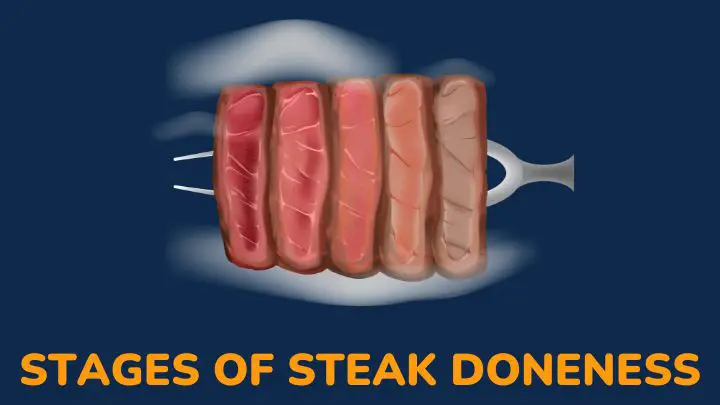Steak perfection is a culinary adventure, and almost unrivaled. If you have tasted one, you will agree. Achieving the perfect steak is possible if you have and follow a guide to the different stages of steak doneness.
There is something they say about how you cook your steak being a reflection of your personality. It is said that people who enjoy their steak rarer are more spontaneous and extroverted, while the less spontaneous would rather have theirs well done.
If you want to express yourself, then, you should know how to cook steak to the different stages of doneness.
What is steak?
Steak is a thick cut of meat usually cut perpendicular to the muscle fibers. Steak may also include a bone or not.
Most steaks are from beef, but you can also get steak cuts with pork, lamb, bison, deer, buffalo, and fish.
Steaks are usually between ½ to 2 inches thick and can be cooked by boiling, grilling, or frying but grilling is the most common method.
Common examples of steak cuts are ribeye, filet, sirloin, and T-bone.
What are the stages of steak doneness?
1. Bleu
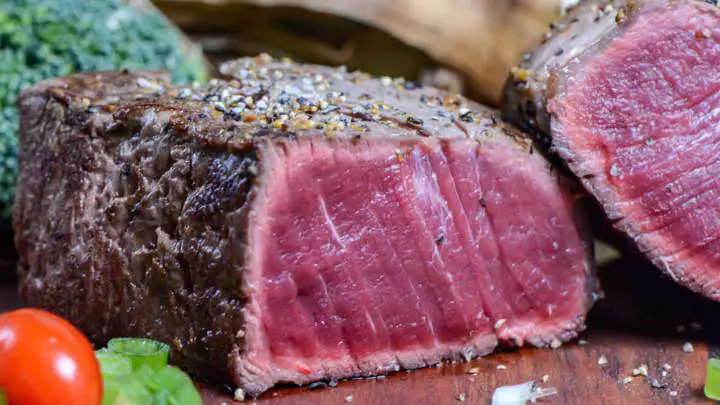
Bleu or blue steak is at one end of the spectrum of steak doneness. Other names for this steak are bloody rare or very rare steak.
This steak is cooked at a high temperature for a very short period. It is seared on the outside and almost uncooked and raw on the inside.
Blue steak is cooked for one minute on each side to a temperature of 115°F (46°C). It is usually still cool on the inside, but you can warm it in the oven at a low temperature.
This stage of doneness is not so common. Moreover, the USDA advises against eating meat cooked below 145°F (63°C).
However, most chefs say the cooking time and temperature are enough to destroy any bacteria on the surface of the meat. That is, it is safe to eat.
This steak pairs well with baked French fries. The crunchiness of the fries nicely contrasts with the soft texture of the meat.
2. Rare
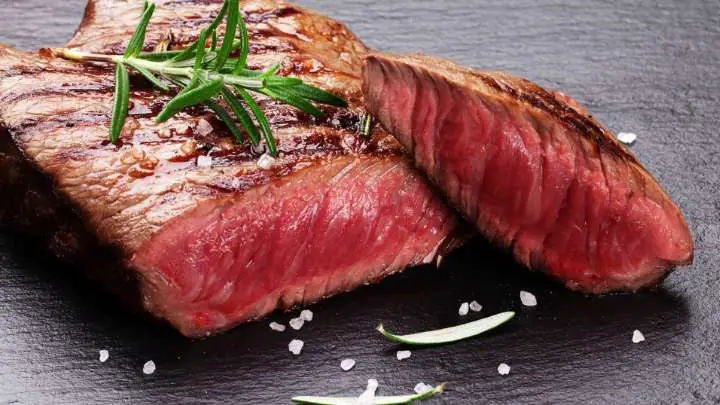
Next on the spectrum is rare steak which is cooked to 120°F (49°C). This is less than the required temperature advised by the USDA, but it is safe to eat.
This amount of heat and the cooking time are enough to destroy any bacteria present on the surface.
The rare stage of doneness is perfect for steak cuts with less fat, such as tenderloins. It is seared on the outside and bright red on the insides.
The steak is usually warm because it is cooked for only about two minutes on each side.
The short cooking time allows the steak to retain all its natural beef flavors and juiciness, which makes it pair well with crunchy chips.
3. Medium rare
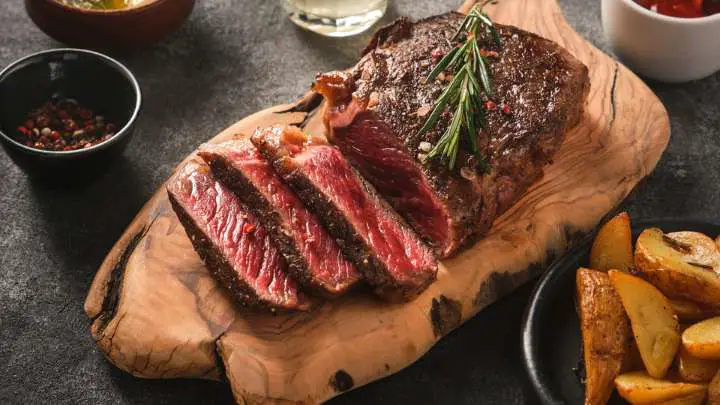
After rare, you can further cook your steak to the medium rare stage. To achieve this, you must cook the steak at 130°F (54°C) for 3 ½ minutes on both sides. Most steak connoisseurs say this is the best way to enjoy steak.
Medium rare stage of doneness brings the best out of the meat. At this point, the steak looks pinkish and brown. It also has a thick brown crust and a red center.
The cooking time and temperature melt the fat well, giving a perfect melt-in-your-mouth experience.
In addition, it is buttery, tender, and juicy because it has not lost most of its moisture. To keep all the juices in, allow the steak to rest for 5 minutes before you into it.
The best way to enjoy medium-rare steak is to pair it with fresh roasted veggies like tomatoes, peas, and runner beans.
4. Medium

There are different levels of cooking your steak to medium. If you want something more cooked than the medium rare, raise the temperature to 140° to 145°F (60° to 63°C) and cook for 4 minutes on both sides.
This level of doneness is usually for people who are more tilted to following rules than adventure.
If you are, this is for you. Medium steak is as buttery and flavorful as medium rare, but it has less moisture, which makes it less juicy and tender.
The exterior is seared, but the inside is browner than red. To retain more juice, allow the steak to rest for 5 minutes before you cut into it.
5. Medium-well
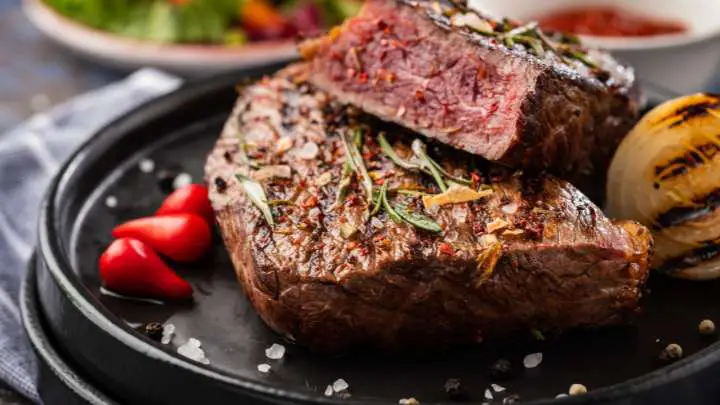
Medium-well steak has a thick brown crust with trace amounts of pink on its inside. This steak stage of doneness is for people who do not care much for the juice.
To achieve this, cook the steak to 150°F (66°C), for five minutes on each side. This steak is tough on the outside and a little tender on the inside, but it is not as flavorful as the other stages of medium doneness.
Not many people intentionally cook their steak to the stage; sometimes, it is a case of overcooked steak, but it remains a preference of some people.
Enjoy your steak with a creamy mash with mustard.
6. Well-done
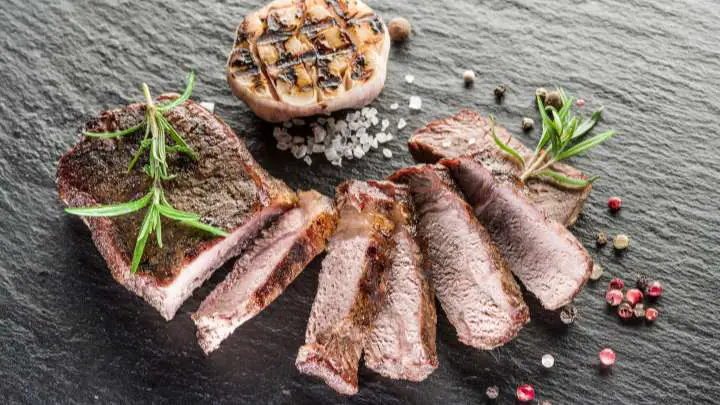
Well-done steak cooks for the longest and at the highest temperature. This level of doneness is for people who prefer dry steak without any juice. To achieve this, cook your steak to 170°F (77°C), for 6-7 minutes on each side.
This steak has a thick brown crust and is well-charred on the sides, top, and bottom. Well-done steak easily becomes dry and chewy.
To avoid this, stop cooking at 165°F (74°C) and leave it to rest. While it rests, it gradually climbs up to 170°F (77°C).
But if you accidentally grilled your steak to the well-done stage, you could soften it by adding a dollop of mayonnaise to it, straight from the grill.
How can you determine the stages of doneness of steak without a thermometer?
There are different ways to determine the stage of doneness of your steak without a thermometer. Two of these methods are:
The palm tests
Raw steak – will feel as soft and fleshy as the skin below your thumb.
Rare – hold your index finger and thumb together and feel the texture of the skin just below your thumb. It should be firmer than the soft fleshy texture for raw meat. This is the texture of rare steak.
Medium rare – move on to hold your thumb and middle finger together. Again, push the skin below your thumb. It will feel slightly tensed than it was when you held your thumb and index finger. This is how medium-rare steak feels.
Medium – hold your thumb and ring finger together and feel the same area below your thumb. The skin will feel sort of flexed, not too firm but firmer than the texture for medium rare. This is what medium steak will feel like.
Well-done – Hold your thumb against your pinkie. The skin below your thumb is fairly firm now. This should be the texture of a well-done steak.
The color of the inside of the steak
If you are sure that you have cooked the meat according to the required cooking time, you can take it off the grill and cut it open.
The inside of a rare steak will be red or light pink on the inside, a medium steak will be bright pink, and a well-done steak will be brown all through.
Are there specific stages of doneness for different steak cuts?
While you may cook your steak to your desired level of doneness, regardless of the cut, some cuts taste better with a specific level of doneness. For instance, strips, skirts, and other cuts of flavorful steak are best cooked rare.
Ribeye, sirloin, and tenderloin cuts are best cooked medium rare. Medium-well and well-done stages of doneness are better for tougher steak cuts.
FAQs
What steak cut cooks the fastest?
Steak cuts with less fat cook faster than cuts closest to the bone. An example of such steak is the filet. The filet has less fat than other steak cuts and is very tender. This is why it is quite expensive.
What level of doneness is the healthiest?
Most steak connoisseurs say that steak is best cooked medium rare. This type of steak is still very tender and has all its flavors and juice.
It also contains more vitamins and minerals than a steak that has been well-cooked. A major drawback of well-done steak is that it contains more potential carcinogens than a steak that is fully cooked.
Can you cook different types of steak together?
You may cook different types of steaks together, but one may overpower the flavor of the other. Also, you risk getting different levels of doneness for the different types of steak. If you don’t mind this, it is fine.
Which steak cut is the toughest to cook?
Primal beef cuts are the toughest cuts to cut. These meats require extra care and time to cook, The best way method for cooking them is low and slow cooking. The primal beef cuts are chuck, rib, loin, round, flank, brisket, shank, and short palate.
Conclusion
Getting a perfect steak is a skill. It requires training, frequent practice, and patience. In all of these, an essential part is knowing the stages of steak doneness.
Each stage of doneness has its unique qualities – cooking time, temperature, texture, and flavor.
If you are used to one style of doneness, get ready to try other stages using this guide. Also, learn about the different steak cuts, you may find some that you never knew existed.
Thanks for reading.
